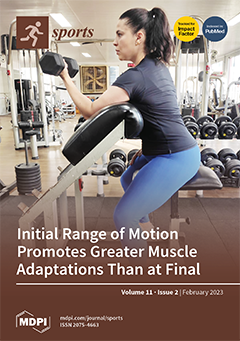Background: During maximal cycling sprints, efficiency (η) is determined by the fiber composition of the muscles activated and cadence-dependent power output. To date, due to methodological limitations, it has only been possible to calculate gross efficiency (i.e., the ratio of total mechanical to
[...] Read more.
Background: During maximal cycling sprints, efficiency (η) is determined by the fiber composition of the muscles activated and cadence-dependent power output. To date, due to methodological limitations, it has only been possible to calculate gross efficiency (i.e., the ratio of total mechanical to total metabolic work) in vivo without assessing the impact of cadence and changes during exercise. Eliminating the impact of cadence provides optimal efficiency (η
opt), which can be modeled as a function of time. Here, we explain this concept, demonstrate its calculation, and compare the values obtained to actual data. Furthermore, we hypothesize that the time course of maximal power output (P
max) reflects time-dependent changes in η
opt. Methods: Twelve elite track cyclists performed four maximal sprints (3, 8, 12, 60 s) and a maximal-pedaling test on a cycle ergometer. Crank force and cadence were monitored continuously to determine fatigue-free force-velocity profiles (F/v) and fatigue-induced changes in P
max. Respiratory gases were measured during and for 30 min post-exercise. Prior to and following each sprint, lactate in capillary blood was determined to calculate net blood lactate accumulation (ΔBLC). Lactic and alactic energy production were estimated from ΔBLC and the fast component of excess post-exercise oxygen consumption. Aerobic energy production was determined from oxygen uptake during exercise. Metabolic power (MP) was derived from total metabolic energy (W
TOT). η
opt was calculated as P
max divided by MP. Temporal changes in P
max, W
TOT, and η
opt were analyzed by non-linear regression. Results: All models showed excellent quality (R
2 > 0.982) and allowed accurate recalculation of time-specific power output and gross efficiency (R
2 > 0.986). The time-constant for P
max(t) (τ
P) was closely correlated with that of η
opt (τ
η; r = 0.998,
p < 0.001). Estimating efficiency using τ
P for τ
η led to a 0.88 ± 0.35% error. Conclusions: Although efficiency depends on pedal force and cadence, the latter influence can be eliminated by η
opt(t) using a mono-exponential equation whose time constant can be estimated from P
max(t).
Full article






